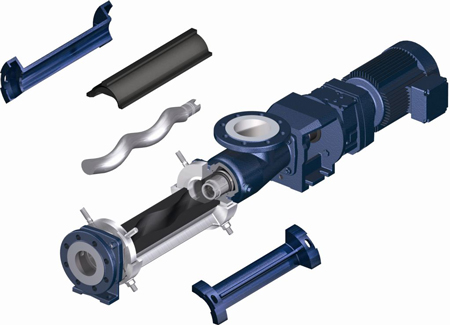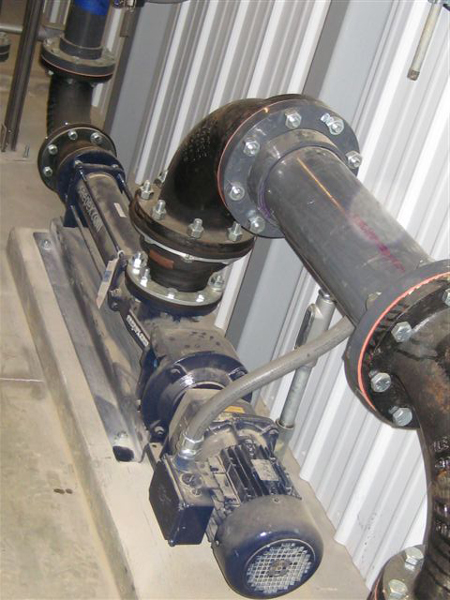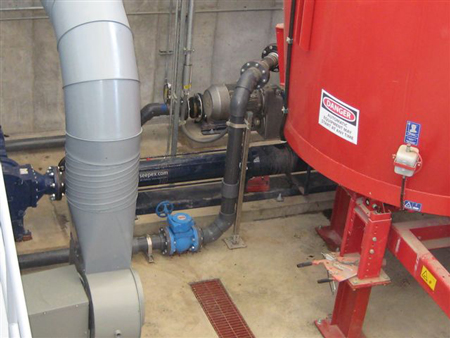New progressive cavity pump technology aids in anaerobic digestion system.
With economic problems and concerns about the environment, one project in Ohio plans to help both issues. More jobs, clean energy, waste reduction and value added products are some of the benefits of anaerobic digestion, and quasar energy group's flagship anaerobic digester facility in Ohio brings these benefits to the state. The partnership of quasar energy group (quasar), Ohio State University (OSU), and the Ohio BioProducts Innovation Center has produced clean, renewable energy in Ohio.
Construction on the Columbus, Ohio, anaerobic digester is almost complete. The 2009 inception of quasar's flagship facility in Wooster was the first step to proving that Ohio's leadership was serious about confronting economic and ecologic problems.
 |
| The progressive cavity pump technology |
An important part of this process has been the use of new progressive cavity pumping technology that enables the movement of the waste materials throughout the anaerobic digestion process. They move the solid waste (food waste, sludge, slurry, etc.) quickly, and these contained, low-maintenance pumps were an attractive fit for bio-waste.
The Process
Anaerobic digestion is a natural process in which microorganisms break down organic material (biomass) in the absence of oxygen. At quasar's facility, the process begins with the arrival of biomass.
For this system, the biomass is made up of:
- Agricultural waste
- Food waste
- Municipal wastewater
A large cone shaped pit receives the waste. A grinder has been integrated into several progressive cavity pumps that move the biomass to the anaerobic digester where “the magic happens.”
The most important factor in the process is the absence of oxygen. Bacterial hydrolysis breaks down insoluble organic polymers, such as carbohydrates, and makes them available to other bacteria.
Acidogenic bacteria convert sugars and amino acids into carbon dioxide, hydrogen, ammonia and organic acids. Acetogenic bacteria also convert resulting organic acids into acetic acid, along with ammonia, hydrogen and carbon dioxide. Methanogens then convert these products to methane and carbon dioxide.

Biosolids pump transferring material between holding tanks
The pumps maintain biomass levels and add additional bacteria as needed. The byproducts of the bacterial breakdown are:
- Energy biogas
- Soil amendment
- Liquid fertilizer
The biogas is burned in a combined heat and power unit creating 600 kilowatts of electricity. The electricity generated is enough to power the facility and a portion of the surrounding community.
The gas is stored in the anaerobic digester's (or silo's) expandable rubber compound roof. The outer membrane protects the inner membrane from the environment. The inner membrane contains the biogas and expands and deflates according to the amount of biogas in the system. When gas is not present, the inner membrane is supported by a column and cable system to keep the it from contacting the biomass. A degassing valve serves as a safety mechanism.
Biosolid transfer pump with integrated MC cutter move the material away from the receiving pit
Positive Results
Columbus, Ohio, is home to approximately 750,000 people. They create a lot of waste, and although water treatment has been in place for a long time, no functional solution has been available for disposing of the remaining dewatered solid waste.
In the past, biomass was disposed of in local landfills. This practice is costly and harmful to the environment. Biosolids emit greenhouse gases, which are a leading contributor to global pollution. Ohio's largest anaerobic digestion plant is the answer to this problem. It has a 1,325,000-gallon system capacity, annual inputs of 45,000 wet tons, 8,760 megawatts of annual electricity, nutrient management and reduced greenhouse gas emissions. It also creates a usable fertilizer instead of harmful landfill waste. The plant will receive biosolids, food waste, fats, oils and grease. In addition to the environmental benefits, this project has also created jobs for skilled labor that are much-needed in the state.
Pumps & Systems, February 2011


